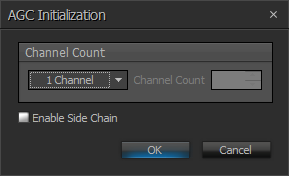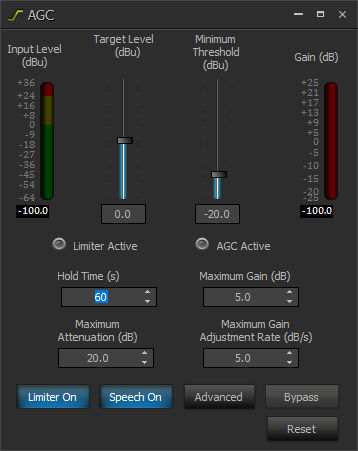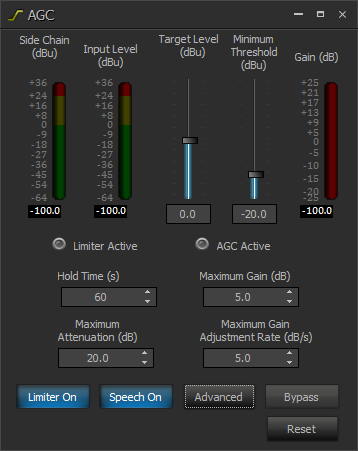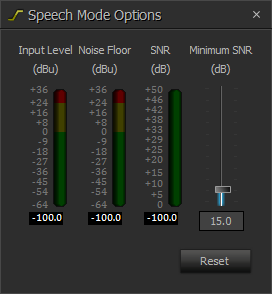AGC
The Automatic Gain Control (AGC) block is a dynamics processing block which regulates the level of an audio signal. Its function is to maintain a relatively constant output level, and it will add or subtract gain in order to bring the level of the input signal closer to the Target Level. The AGC block only adjusts gain when it receives a qualifying input signal (see “Qualifying Input Signals” below). There is only one Side Chain port and one Logic Output per channel for the AGC.
The AGC block can optionally utilize SpeechSense™ technology to make better decisions about when to make level adjustments. It can also be optionally triggered from a side chain input.
Initialization Dialog

| Name | Description |
| Channel Count | Select from a list of default channel counts or set a custom amount (up to 32). |
| Enable Side Chain |
Enable Side Chain can be toggled on or off. (Side Chain input details below) |
DSP Block Representation
Without Side Chain Enabled:


With Side Chain Enabled:


More information on logic is located here: AGC
Control Dialog
The control dialog has two different layouts, one for a single channel selection, and another for a multi-channel selection. Multi-channel blocks will have meters available in a window accessible via the meters button.

- Side Chain meter shows the level of the side chain input. It is only visible when the Side Chain input has been enabled.

- Input Level meter shows the level of the input signal.
- Target Level is the signal level that the AGC block will work to output. If the input level is higher than the target level, the AGC block will subtract gain. If the input level is lower than the target level, the AGC block will add gain.
- Minimum Threshold is the minimum input signal level required for the AGC to make adjustments. The Maximum value for the Minimum Threshold will be the Target Level. If the input signal level is lower than the minimum threshold, the AGC block will temporarily suspend gain adjustments.
- Gain shows how much gain is currently being added or subtracted from the input signal.
- Limiter Active will light when the clip limiter is actively engaged in preventing clipping.
- AGC Active will light when the AGC block is making a gain adjustment.
- Hold Time is the number of seconds that the AGC block will hold the current Gain setting while not receiving a qualifying input signal. After the Hold Time elapses, the AGC block will reset the gain to zero.
- Maximum Gain defines the maximum amount of gain that the AGC block will add to the signal.
- Maximum Attenuation defines the maximum amount of gain that the AGC block will subtract from the signal.
- Maximum Gain Adjustment Rate defines how quickly the AGC block can adjust the gain, specified in decibels per second.
- Limiter On/Off turns the clip limiter feature on or off. When the clip limiter is on, the AGC will temporarily reduce the gain applied to the input signal if that gain would have caused the signal to clip. Gain adjustments made by the clip limiter may briefly exceed the Maximum Gain Adjustment Rate as necessary to prevent clipping.
- Speech On/Off turns SpeechSense™ technology on or off. When Speech mode is on, the AGC analyzes the input signal to determine if it is human speech. Non-speech signals will not cause the AGC to adjust the gain when Speech mode is on.
- Advanced opens the Speech Mode Options window (see below). These advanced controls are only available when Speech mode is enabled.
- Bypass disables the AGC without changing the settings.
- Meters opens a window that displays the meter information. (Multi-channel blocks only)
- Reset will adjust settings to the default block values.
Advanced Speech Mode Options Dialog
The Advanced Speech Mode Options Dialog has meters for Input Level, Noise Floor, and SNR. There will only be one Minimum SNR adjustment regardless of the number of channels.


- Noise Floor meter shows the estimated level of the noise floor of the input signal. The Noise Floor is used in calculating the Signal-to-Noise Ratio.
- SNR meter shows the Signal-to-Noise Ratio of the input signal. This is equal to the Noise Floor level subtracted from the Input Level. In general, the closer the talker is to the microphone, the higher the Signal-to-Noise Ratio will be while they are talking.
- Input Level shows the level of the input signal.
- Minimum SNR determines how high the Signal-to-Noise Ratio (SNR) must be before the AGC will make gain adjustments. If the SNR is below the minimum, the AGC will temporarily suspend gain adjustments.
Qualifying Input Signals
The AGC block will only adjust its gain when it receives a qualifying input signal. The definition of a qualifying input signal depends on whether Speech Mode is on or off. When the input signal is not a qualifying signal, the AGC block will hold its previous gain setting until it receives a qualifying signal or until the Hold Time elapses.
When Speech mode is ON, a qualifying signal must satisfy ALL of the following:
- Level of input signal must be above the specified Minimum Threshold.
- Input signal must be human speech.
- Signal-to-Noise Ratio must be above the specified Minimum SNR setting.
When Speech mode is OFF, a qualifying signal must satisfy the following:
- Level of input signal must be above the specified Minimum Threshold.
Side Chain Input
The optional Side Chain input can be enabled when the block is initially created (or by right-clicking on the block and choosing “Edit Block Parameters”). When the Side Chain input is enabled, the signal connected to the Side Chain (SC) is evaluated and used by the AGC block for control processing (instead of the 'level' of the main Input Signal). This means the AGC calculates the amount of gain required from the Side Chain input to bring the Input signal to the Target Level, then it applies that amount of gain to the Input Signal.
Logic Output
The logic output on the AGC block will generate a logic HIGH signal when the AGC block is actively making adjustments. In other words, whenever the AGC Active light is lit, the logic output will go HIGH.



